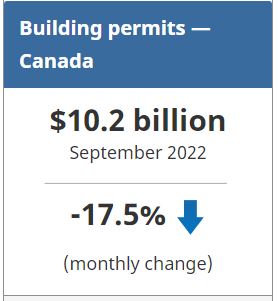Statistics Canada: Building Permits September 2022
The total value of building permits in Canada fell 17.5% in September to $10.2 billion, the largest recorded monthly decline. This was the first time all survey components posted monthly decreases since September 2019. Both the residential (-15.6% to $7.0 billion) and the non-residential (-21.5% to $3.2 billion) sector posted declines.

On a constant dollar basis (2012=100), the total value of building permits dropped 17.8% to $6.0 billion.
Multi-family component drags down residential sector
The value of residential permits decreased 15.6% to $7.0 billion nationally in September, with a similar decline in the number of units (-16.0%) being built.
The value of building permits in the multi-family component tumbled 21.2%. This drop was largely due to Ontario, which fell 39.6% following a record high in August. While August saw the submission of four permits valued at over $100 million in Ontario, including one for $480 million, there were no permits in September to break the $100 million mark.
Construction intentions in the single-family homes component declined 7.7%. Seven provinces posted decreases, with notable declines in Ontario (-7.0%), Manitoba (-35.1%), and Alberta (-15.9%).
Non-residential sector down across all components
The total permit value of the non-residential sector decreased 21.5% to $3.2 billion in September.
The institutional component, after three consecutive monthly increases, dropped 37.2% in the month.
Construction intentions in the commercial component fell 11.5%, with decreases posted in nine provinces. The two provinces to post gains were British Columbia (+37.9%), after three consecutive monthly declines, and Quebec (+22.3%), after posting the lowest value of the year in August.
The value of building permits in the industrial component declined 23.4%, reaching the lowest point since late 2021 and has been on a downward trend since then.
Third quarter construction intentions slow down
The total value of building permits in the third quarter of 2022 decreased 6.3% to $33.7 billion after three consecutive quarterly increases.
The residential sector declined 5.6% in the quarter, with decreases posted in all provinces, returning the sector to historic levels following a strong second quarter. Single-family permits declined 9.0%, while multi-family permits were down 2.6%.
Overall, the number of new units slated for construction in the residential sector declined 7.4%. Much of the decrease stemmed from the multi-unit component (-7.8%) as it reached its lowest point since the third quarter of 2020. Single-family intentions saw a 6.2% decline.
The non-residential sector saw a 7.9% decrease to $10.8 billion, with declines in all components.
The industrial component (-19.3%) was the biggest drag on the sector, after reaching a new record high in the first quarter of 2022. The commercial component decreased 1.8% after six consecutive quarterly increases. The institutional component (-10.1%) continued to cool off after nearly hitting the $4 billion mark in the first quarter of 2022.
To explore data using an interactive user interface, visit the Building permits: Interactive Dashboard.
To explore the impact of the COVID-19 pandemic on the socioeconomic landscape, please consult the Canadian Economic Dashboard and COVID-19.
For more information on housing, please visit the Housing statistics portal.
Statistics Canada has a Housing Market Indicators dashboard. This web application provides access to key housing market indicators for Canada, by province and by census metropolitan area. The indicators are updated automatically with new information from monthly releases, giving users access to the latest data.
To read the full report, click here.
Note to readers
Unless otherwise stated, this release presents seasonally adjusted data with current dollar values, which facilitate month-to-month and quarter-to-quarter comparisons by removing the effects of seasonal variations. For information on seasonal adjustment, see Seasonally adjusted data – Frequently asked questions.
Building components
- Single-family dwellings: Residential buildings containing only one dwelling unit (e.g., single-detached house, bungalow, linked home [linked at the foundation]).
- Multi-family dwellings: Residential buildings containing multiple dwelling units (e.g., apartment, apartment condominium, row house, semi-detached house).
- Industrial buildings: Buildings used in the processing or production of goods or related to transportation and communication.
- Commercial buildings: Buildings used in the trade or distribution of goods and services, including office buildings.
- Institutional and government buildings: Buildings used to house public and semi-public services, such as those related to health and welfare, education, or public administration, as well as buildings used for religious services.
Revision
Data are subject to revisions based on late responses, methodological changes and classification updates. Unadjusted data has been revised for the previous month. Seasonally adjusted data has been revised for the previous three months.
For information on trend-cycle data, see the StatCan Blog and Trend-cycle estimates – Frequently asked questions.
Next release
Data on building permits for September will be released on December 5th.
Source: Statistics Canada

